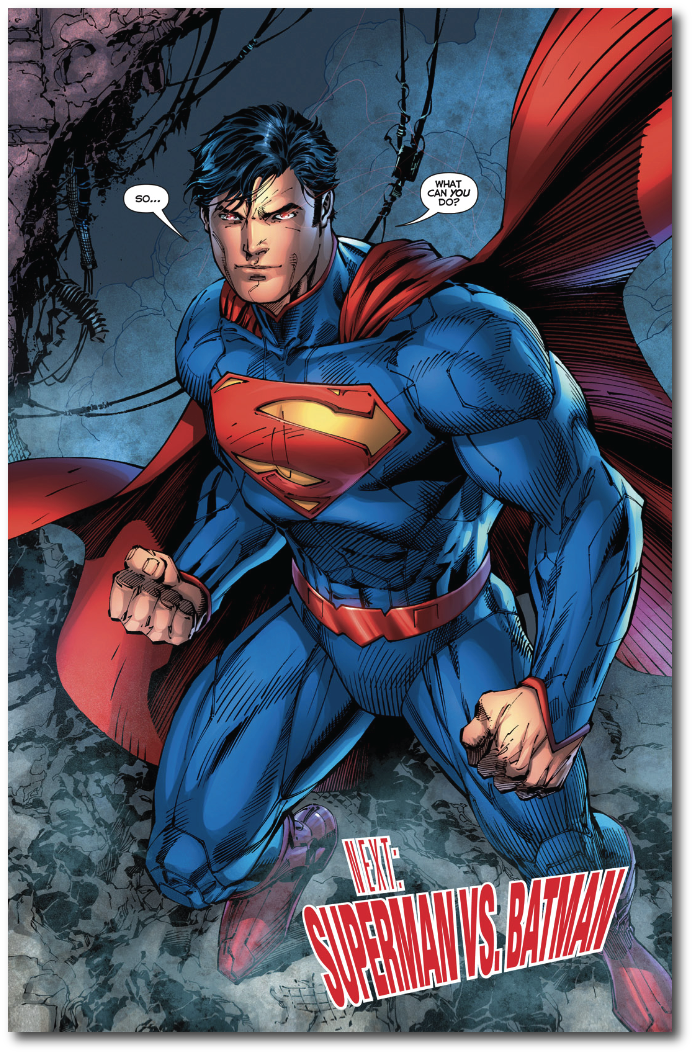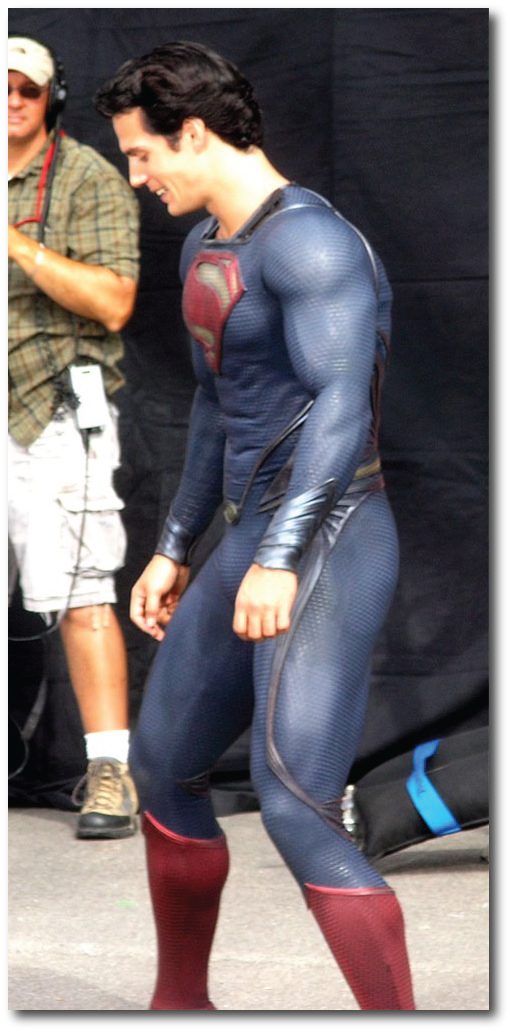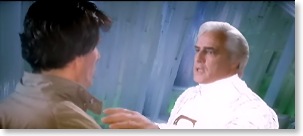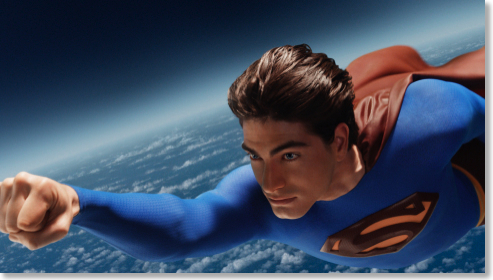
I can't remember a world without a Superman. He was part of the modern world's mythology instilled to me by my parents from a very early age. As soon as I could begin reading (which was pretty early), my father bought me Superman comic books. I wish I still had those exact issues. I continued to buy comic books on my own up until shortly before Kathy and I got married in 1990 (I couldn't afford both). The Superman of the comics most familiar to me was the one drawn by Curt Swan, spanning almost three decades until John Byrne revamped the Man of Steel in the mid-eighties. However, I was also very familiar with the early Superman of the late-thirties, forties, fifties and sixties thanks to reprints and collections of stories in books. Superman was always one of my favorite heroes, if not the favorite (with the possible exception of the Fawcett Captain Marvel of the forties and fifties, but that's a subject for another day).
And then there was the Superman of television and film. As a kid I watched (in reruns) the late, great George Reeves (Adventures of Superman) don the cape. In many ways, although he was the Superman of my parents' generation, he set the standard for me as to what Superman should embody as a hero. I was eleven when Superman: The Movie, starring Christopher Reeve hit the theaters. For the two or three years leading up to its release, this movie had been hyped in the comic books with a two-page contest explaining how "You Could Be in the Superman Movie." I wondered if I won that contest if they'd let me play Jimmy Olson. Years later I would find out that the two winners of that contest got to act as stand-in players on the Smallville football team, and if they were actually able to spot themselves in that very brief scene, perhaps there is such thing as super-vision.
Superman: The Movie (1978) marked a shift in super-hero movies, and would not be topped stylistically for at least eleven years until 1989's Batman. Even at the age of eleven, I could tell that this film was treating the character seriously. It had well-known actors like Marlon Brando as Jor-El and Gene Hackman as Lex Luthor. Even today, it's hard for me to see Hackman as anything but Luthor because that's where I first noticed him. The special effects, though a bit dated today, were cutting edge for the time. The tagline for the movie had been "You will believe a man can fly." And we did. Even watching the film recently, some (but not all) of the flying scenes are quite smooth. Before anyone depicted flying in films was obviously set in front of a blue screen. Not so with at least some of the scenes in Superman: The Movie. Even today, the film stands up fairly well and no doubt that for many, when they think of Superman, they think of Christopher Reeve. To me the movie is well done up until the last quarter or so. The whole turning-back-time-by-flying-very-fast-against-the-world's-rotation shtick didn't impress me even when I was eleven. Plus, as I verified while watching this movie again the other day, Superman still doesn't stop the second missile from hitting, he just saves Lois Lane. It makes you wonder who he didn't save in order to achieve this?
The scripts for Superman: The Movie and Superman II were both written by Mario Puzo of The Godfather fame. Although I liked the story line in the second installment involving the Phantom Zone villains (a great continuation and connection to the first movie), even as a boy, by that time at age 13, I did not care for the personal themes in Superman II. It wasn't merely Superman and Lois lane engaging in unmarried sexual intercourse (something that had never taken place in the comic books), it was the personal choice that Puzo had Superman make. Here was earth's protector choosing to give up his powers and abilities to have a normal life with the woman he loved, Lois Lane. Maybe that's a romantic decision for some, but then and now, it seemed like a very selfish and unheroic choice. It was a choice seemingly made on impulse without thought for the rest of humanity. It was a choice madewithout wisdom. I could never imagine the George Reeves' Superman making such a choice for Noel Neill (the television Lois Lane).
Superman III, which featured then popular comedian Richard Pryor, is largely unforgettable with the exception of the fight between Superman and Clark Kent (you'd have to see the movie to understand). That scene, to me, is one of the most clever psychological visualizations I've ever seen on film.Superman IV: The Quest for Peace, co-written by Christopher Reeve himself, suffers from obviously political overtones and perhaps one of the worst edits of a film I've ever seen. I remember watching the movie and wondering how the characters got from one scene to another, feeling as if something was left out. After reading a comic book adaption based on the shooting script, the story made more sense, but the product on the screen seemed incredibly rushed. The failure of this movie ended Christopher Reeve's run as the Last Son of Krypton.
The nineties saw a number of attempts to resurrect the franchise. For a while Tim Burton was schedule to direct the film. This project went far enough to see teaser posters created. Personally, while I thought Burton was a great match for Batman, I did not want him to touch Superman. The same thing goes for Nicholas Cage, who unimaginably for a time was in talks to play Superman. Cage is one of my favorite actors, but he'll make a better Ghost Riderthan Superman.
So finally, after nineteen long years, Superman Returns. Rather than reinvent Superman the way Burton planned, director and story co-writer Bryan Singer, chose to pick up where the Mario Puzo stories of Superman and Superman II left off. Ignoring the events of Superman III and IV (just as well),Superman Returns is a thematic sequel to the first two films, especially the second. John Williams' unforgettable theme music (by now inseparable from the Superman mythos) returns, although Williams himself does not score this movie. The only actor from the originals to return is Marlon Brando in spite of the fact that he's dead! But this was an incredibly clever choice. Another actor from the 1978 film showing his face is Glenn Ford, who played Jonathan Kent in the original. His picture is clearly visible on the mantle in the Kent farmhouse. Even the opening titles for the new film are done in the same style as the original movies. Seeing that lettering and hearing the John Williams' music transported me back momentarily to my childhood.
SPOILER ALERT: Read no further if you haven't seen the movie yet. Superman Returns is everything Superman III should have been in 1983. The events in Returns take place five years after the events in Superman II. Over these five years, Superman (Brandon Routh) has been missing. We find out that in response to astronomers' discovery of Krypton, Superman has been on a long galactic journey to see if anything remains of his homeworld. Finding nothing, he comes home. Of course, it's never explained how Superman can get there and back in a span of five years even though Jor-El has stated that he's been dead for thousands of earth years. Oh well.
During this time, no only has life moved on for Lois Lane (Kate Bosworth), she is now a mother and engaged to Richard White (James Marsden of X-Men fame who gets more screentime in this movie than he did in X-Men II and III combined), the nephew of Daily Planet Publisher Perry White (played expertly by Frank Langella, although I miss Jackie Cooper). Hell hath no fury for Lois Lane scorned, and to prove it, she has won a Pulitzer Prize (a goal mentioned more than once in the first two movies) for her editorial, "Why the World Doesn't Need a Superman." It seems the boy in blue left without even as much as a goodbye, something she (rightly) took very personally.
The Richard White character is handled quite well. From a formulaic standpoint, usually an audience is made to hold contempt for any third wheel getting in the way of the characters you want to see hit it off. This is normally necessary so that he can be eventually discarded. When first introduced to Richard White in the movie, I wanted to dislike him, but as the movie progressed, that became something very difficult to do. I found myself feeling sympathy toward White, who was clearly insecure about Lois' past relationship with Superman--I mean, what man wouldn't be? Further, White is established as heroic in his own right, despite not being able to bend steel in his bare hands. Further (I warned you about spoilers), he is not removed from the triangle at the end of the movie, but the security of his relationship with Lois is at least questionable now that Superman's back in town.
The more significant plot point regarding Lois is her five-year-old son--coincidentally the same age as the length of time that Superman has been gone. Hmmm.... I'm going to break a golden rule of movie reviewing for the sake of later discussion and reveal to you that, yes--if you hadn't already guessed it--Jason Lane is actually Superman's son, the result of their coupling in Superman II. Of course, Time Magazine revealed the secret this week before me.
The third plot point revolves around Superman's arch-nemesis, Lex Luthor (Kevin Spacey). Superman has not only been an absentee father to his son, but he failed to make the parole hearing for Luther who is now legally a free man. And having visited Superman's Fortress of Solitude in Superman II, he goes back there to steal Kryptonian technology. Just as in Superman: The Movie, Luthor has a real estate scheme; although this time, he's creating a new continent rather than dropping missiles on an old one. Of course, just like the first time, if he succeeds, billions will die in the process because raising a new land mass will cause flooding of existing ones.
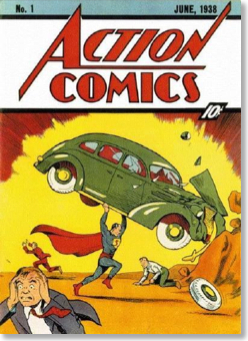
Bryan Singer is an incredible director and story-teller. You can tell he is a true Superman fan, familiar not just with the movies, but also with the comic books. In this movie Superman is doing very Superman-like things--walking through sprays of machine gun bullets, preventing a plane crash, tunneling through the earth. Kathy and I were in a theater on opening day and the audience was quite fun--they applauded and cheered at all the appropriate times. The 1938 Action Comics #1 cover in which Superman lifts a car over his head is reproduced in the movie, something that the true fan will instantly recognize. Regardless of whether in the end a viewer likes this film or not, I can't see how anyone would not feel excitement and awe at the end of Superman's first appearance when he keeps a Boing 777 from crashing.
Although the 1978 film was supposed to make us "believe a man can fly," the flight in Superman Returns is how I imagine it really would be. There's not one scene that looks superimposed over a blue screen thanks to modern computer graphics and computer-based editing. And as opposed to the Christopher Reeve Superman, who when flying at tremendous speeds still never messed up his hair and his cape only lightly flapped, Routh's Superman's hair looks like he's riding in a convertible and his cape really seems to be pulling hard in the wind. Speaking of the cape, Superman's costume in this movie is slightly altered. The colors are darker for a modern audience (watching the original movies a few days ago, Reeves' costume comes across almost like pajamas by today's standards). The "S" on Superman's chest has been slightly altered somewhere between the version we're most familiar with and the original 1940's Siegel and Shuster rendition. However, Singer goes crazy with that S and it becomes superfluous. The S on his belt is redundant to the one on his chest. And there are even little S's on the heels of Superman's boots--oh my.
Besides the aforementioned connections to the earlier Superman movies, there are two nods to the fifties' Adventures of Superman television show. Noel Neill (the Lois Lane of the forties serials and seasons 2-5 of the TV show) and Jack Larson (Jimmy Olson of the TV series) both have roles in the movie. Although their roles are small, they are significant characters, not merely walk-ons such as when Stan Lee makes a cameo in a Marvel Comics movie. Neill's character is in a very early scene and although she was unrecognizable physically, her voice instantly gave her away to those of us familiar with the show. Larson's character is actually in a scene with the new Jimmy Olson (Sam Huntington) which makes it even more memorable.
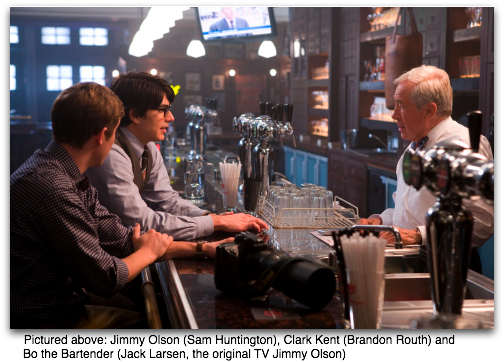
Speaking of cameos, folks familiar with billionaire adventurer, Sir Richard Branson will spot him as one of the space shuttle pilots in one of the movie's early scenes. I wonder how much he paid to be in this movie? More trivia: Noel Neill has now been in more Superman renditions than any other actor. She played Lois Lane in the movie serials with Kirk Alyn and in the television show with George Reeves. In Superman: The Movie--if you can view an uncut version--she plays the mother of a very young Lois Lane who, while riding on a train, sees a young Clark Kent run speeding past. Kirk Alyn is also in that scene playing Lois' father. Neill also guest starred on a episode of the Superboy TV show.
Brandon Routh obviously won the part of Superman because he bears not an identical, but a striking resemblance to Christopher Reeve. But in all fairness, not everyone would be able to easily wear that costume. While Routh captures the essence of his predecessor, and some of his lines sound almost exactly like Reeve's (in fact, at least two lines are identical to those in the 1978 movie), he also makes the character into his own. When the bank robber shoots Superman in the face--actually in the eye--Routh's Superman looks ticked off in a way that I don't ever remember seeing in the Christopher Reeve portrayal of Superman. And Routh's Clark Kent goes even beyond Christopher Reeve's performance making him not just a nerd, but an outright geek (there is a difference, you know).
Incidentally, according to the trivia on the IMDB, Routh thought he had blown the role when at his first meeting with Singer, he stumbled and spilled coffee all over the table where they were sitting. However, Singer later told him that blunder helped get him the role because it convinced him that he could play not only Superman but Clark Kent as well.
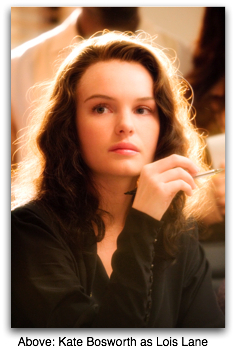
Some will disagree with me, but I never saw Kate Bosworth as Lois Lane. She didn't have the spirit of Margot Kidder, the charisma of Teri Hatcher, and certainly not the brass of Noel Neill. There was great chemistry between Kidder and Reeves in Superman I and II. But even with characters' relationship estranged, I never saw any such connection between Routh and Bosworth. I kept wondering what Superman saw in this Lois anyway. To me, Bosworth's Lois came across a bit flat and lacks energy, but in interviews of Bosworth I've seen, she comes across that way in real life.
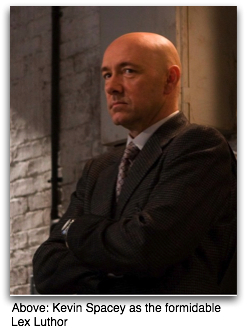
Kevin Spacey makes a wonderful Lex Luthor, who in the end was not quite over-the-top as one of my friends feared based on previews. Rather, he was a much darker and seemingly smarter Lex Luthor than the Hackman version. In one interview that I saw, Spacey says that after accepting the role, he purposefully did not go back and watch Gene Hackman's version of Luthor so that he could make the role into his own. For this type of Lex Luthor, I believe Spacey was the best casting choice imaginable. And fortunately, there was no "Otis-like" character as in the Puzo scripts, which I believe took away from Luthor's character. However, I hope that one day we can get beyond the Puzo version of Lex Luthor who simply seems to pursue one land scheme after another. I like the John Byrne version of Luthor depicted in the comic books who is not only a scientific genius, but also a politician who runs and wins the presidency making Superman's conflict with him even more complex. This is the Luthor I'd like to see on film. Michael Rosenbaum's Luthor onSmallville, by the way, is a nod toward Byrne's version.
One of the strengths of the movie and certainly part of Singer's genius was to tie this Superman movie to the iconic versions from 1978 and 1980. However, in my opinion, this is also one of the film's greatest weaknesses. The ultimate connection to Superman II is the night that Superman and Lois spent together in his Fortress of Solitude. Lois' son is the consequence of this action. So, now the storyline begun with Superman's selfish disregard for all of humanity is now continued with his role essentially as that of an absentee father, perhaps even a "deadbeat dad." He certainly didn't pay child support during those five years he was gone, did he? Rather he left mother and son in the lurch. Granted, he didn't know about the Jason, but he didn't have a chance to find out because he left earth without telling Lois goodbye. C'mon, Superman, get a spine. This is certainly not heroic actions. Is this Superman supposed to look more human to us? Is he supposed to be an example perhaps to unwed fathers because now he's going to take responsibility for the child? I don't know. Again, I could never see George Reeves in this situation, and it's not what I want in Superman. Unfortunately, now that Singer has resurrected this storyline, I can only imagine that I won't see the kind of Superman movie I really want until I'm a very old man, if then.
Plus, here's an interesting continuity question. If Clark Kent (who as Superman had all kind of "extra" never-seen-before-or-since powers in Superman II) removed Lois' memory of events and his secret identity with some kind of super-kiss at the end of the second movie, how in the world does she know that Jason is Superman's son? This question is never addressed, let alone answered in Superman Returns. One wonders whether or not Lois shouldn't speculate that the child was some kind of "virgin birth."
Speaking of such things, it's hard to deny the Judeo-Christian imagery in the Superman myth. Superman is the story of a savior sent to our world from a heavenly father, who's last name just happens to be "El," the Hebrew word for God. In the Christianity Today interview, Singer rightly points out that Superman started out as more of a Moses figure seeing as Superman's creators Jerry Siegel and Joe Shuster were both Jewish. However, the story has been written and rewritten by many, many different writers over the years and the Christian imagery has grown. In fact, in the 1990's "Death of Superman" saga, Superman actually died and rose from the grave! There is a new book out that explores some of this imagery in the Superman myth, but from the reviews of it I've seen, too much is being read into the story. A better treatment of this imagery is in John Galloway's The Gospel According to Superman written about three decades ago. Although it's out of print, used copies are still attainable.
Bryan Singer, although Jewish, certainly plays this Christian imagery up in the film. The Superman of this movie hears the voices of everyone at once, like the God of the Bible who can hear the prayers of all people. There's much talk in the movie about whether or not the world needs not just a Superman, but a savior (that exact word is used). Jor-El's words from the first film about sending "my only son" are repeated. Superman is stabbed in the side like Christ, and toward the end, even stretches out his arms in a very Christ-like pose.
Personally, I'd rather leave the Christ analogies out. I love the Superman story, but Superman is not Jesus. And the Puzo-Singer Superman, the one who selfishly gave up his powers and had what turned out to be a one night stand in Superman II, resulting in a son of his own in Superman Returns is notmy Jesus. Pardon me for saying this but the Superman of the Puzo-Singer storyline has more in common with Dan Brown's Jesus of the Da Vinci Codethan the Superman of the Bible. Forgive me, but I'd simply prefer to keep Jesus and Superman separate (notwithstanding that Jim Caviezel was turned down for the role of Superman for this movie).
Kathy and I saw the IMAX 3-D version of Superman Returns. I hadn't been to a 3-D movie in years, and I thought this might make a good one to see with the effects. However, while fun, it doesn't really add anything to the story and may actually take away from it because the viewer is more concentrated on the effects than the story. In the end, there was less than 20 minutes of the two and a half hour movie that were actually in 3-D with nothing in the second half in 3-D at all except for the final flight scene. My hunch is that the team responsible for adding the 3-D effects simply ran out of time. These days, the final cut of a movie is often completed mere weeks before actual release. The lack of 3-D scenes in the second half and especially during the opening titles (which scream 3-D) seems to give away this tight schedule.
Go see Superman Returns. Overall, it is a good installment in the series. If you saw the first parts of the storyline as a kid like I did, it will take you back to your childhood. Just don't put the Man of Steel on too high of a pedestal. Remember instead that the world actually does have a Savior, and he's not vulnerable to Kryptonite, let alone rash choices.
 Thursday, September 8, 2011 at 6:46AM
Thursday, September 8, 2011 at 6:46AM 